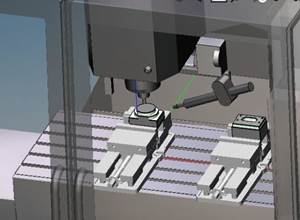Buying Preferences Of Moldmakers
CIMdata recently conducted an extensive worldwide study of moldmakers to better understand current moldmaking operational processes and technologies being employed, issues being faced by mold producers, their plans to remain competitive in a tough worldwide environment and the requirements that they place on their CAD/CAM suppliers. One of the many areas examined and presented in this 135-page report was that of CAD/CAM buying preferences.
Share





CIMdata recently conducted an extensive worldwide study of moldmakers to better understand current moldmaking operational processes and technologies being employed, issues being faced by mold producers, their plans to remain competitive in a tough worldwide environment and the requirements that they place on their CAD/CAM suppliers. One of the many areas examined and presented in this 135-page report was that of CAD/CAM buying preferences. Comparisons were drawn among North American, European and Japanese moldmakers, and it turned out that there are significant differences among moldmakers in each of these geographies.
Some of the preferences considered in the survey and discussed below are:
Openness to alternative suppliers—Approximately 70 percent of worldwide moldmakers are generally open to the use of alternate suppliers and CAD/CAM products. The remaining 30 percent were committed to their existing suppliers. Approximately 80 percent of Japanese mold producers were open to alternative vendors, but only 60 percent of European companies responded in this way. This may be good news for vendors entering the Japanese market, but it is less favorable to suppliers attempting to acquire new accounts in Europe. In North America, 70 percent of the firms took this position.
Moldmakers that are committed to a particular vendor or product were asked why they were not open to other options. Approximately half of this group indicated that they are fully satisfied with their current product and have no interest in exploring alternatives. Approximately one quarter have no control over the product selection, in that a corporate group decides on the product to be used. The remaining quarter indicated they are committed to using the same product as their primary customer in order to maintain compatibility.
Type of offering—Moldmakers were asked if they prefer a CAD/CAM product that is totally focused on mold producers, an integrated CAD/CAM solution or a generic "best-in-class" offering. More moldmakers worldwide (45 percent) prefer a product that is specifically directed at their needs as compared to a more generic offering. Approximately 35 percent of moldmakers opt for an integrated CAD/CAM offering, while 20 percent prefer a generic "best-in-class" type of product.
There are some major differences in preference among the geographical area. For example, more than half of the North American moldmakers would rather have a product focused on moldmakers, while more than half of the Japanese firms would select an integrated CAD/CAM solution. European companies are more closely divided with 40 percent opting for a product focused on mold producers and an integrated CAD/CAM offering, while 20 percent would select a generic product.
One or multiple vendors—Moldmakers worldwide endorse the desirability of a single vendor, as approximately 70 percent of companies favor this approach. North American mold producers are even stronger in this preference, as nearly 75 percent favor a single vendor. This position is shared by about 65 percent of European firms.
Sales representation—The results of this survey reveal that users generally prefer to deal with vendor salespeople, as half of the respondents selected this option. Approximately 30 percent favor interacting with a reseller and 20 percent favor a service provider or system integrator. This data should give vendors some pause in that the trend is toward less use of direct salespeople and greater use of resellers. While no company in the survey preferred either a storefront or use of a Web site, CIMdata believes that use of a Web site will become more accepted.
Related Content
Cutting Part Programming Times Through AI
CAM Assist cuts repetition from part programming — early users say it cuts tribal knowledge and could be a useful tool for training new programmers.
Read MoreBlueprints to Chips: CAD/CAM Tips and Tricks
This collection of articles delves into the latest CAD/CAM innovations, from AI-driven automation and optimized tool paths to the impact of digital twins and system requirements.
Read MoreHow Integrated CAD/CAM Transforms Inventions Into Products
The close connection between CAD and CAM is what links creative ideas to practical production for this unique custom manufacturer.
Read MoreFive-Axis CAM Strategies Cut Cycle Time for Two Shops
After being acquired by the same parent company, two shops found that working together and sharing knowledge improved both of their bottom lines.
Read MoreRead Next
Machine Shop MBA
Making Chips and Modern Machine Shop are teaming up for a new podcast series called Machine Shop MBA—designed to help manufacturers measure their success against the industry’s best. Through the lens of the Top Shops benchmarking program, the series explores the KPIs that set high-performing shops apart, from machine utilization and first-pass yield to employee engagement and revenue per employee.
Read MoreAMRs Are Moving Into Manufacturing: 4 Considerations for Implementation
AMRs can provide a flexible, easy-to-use automation platform so long as manufacturers choose a suitable task and prepare their facilities.
Read More

















